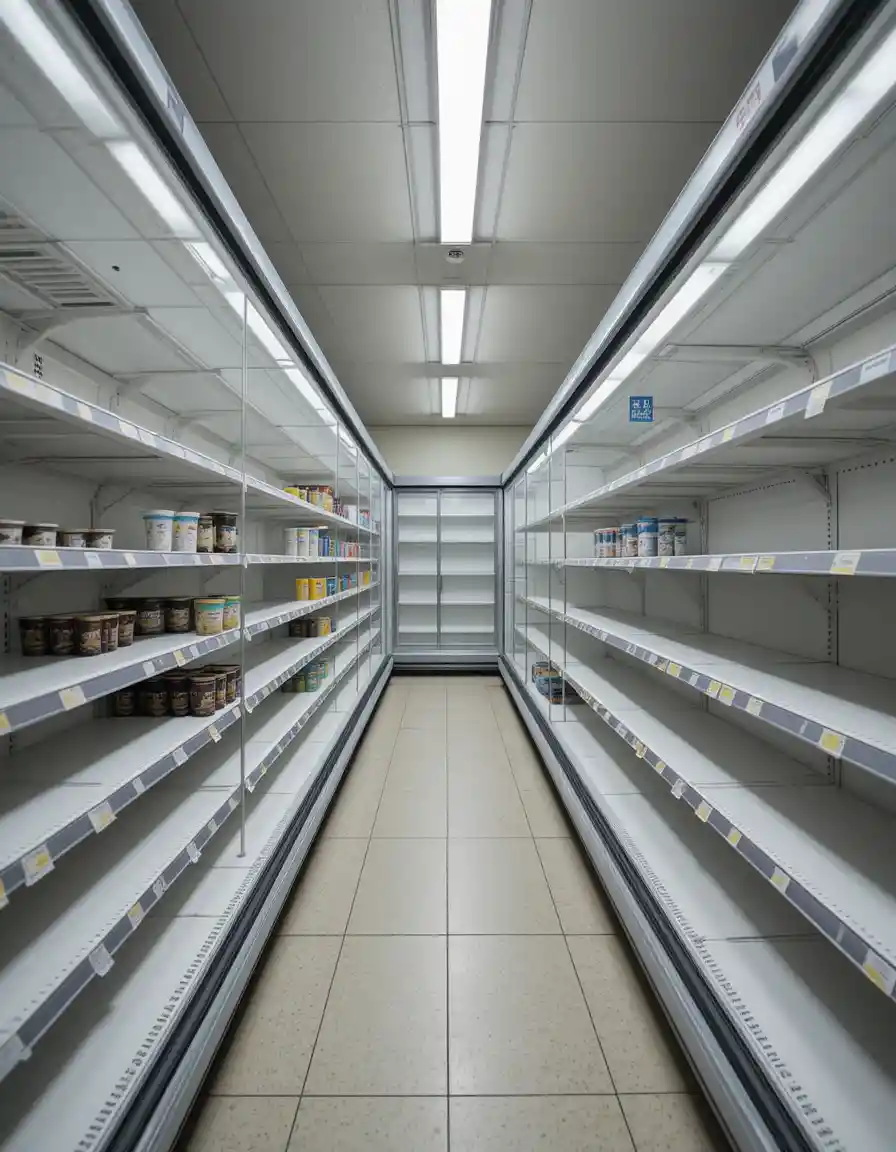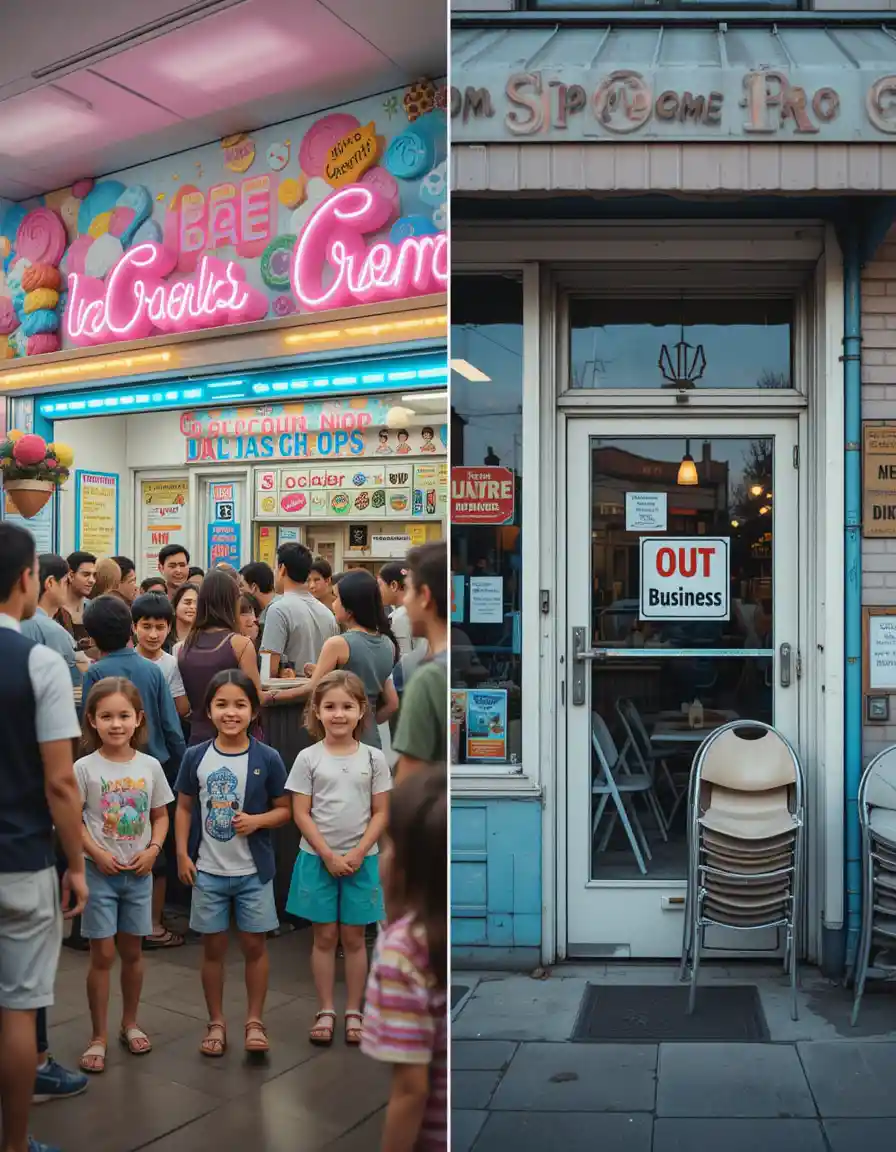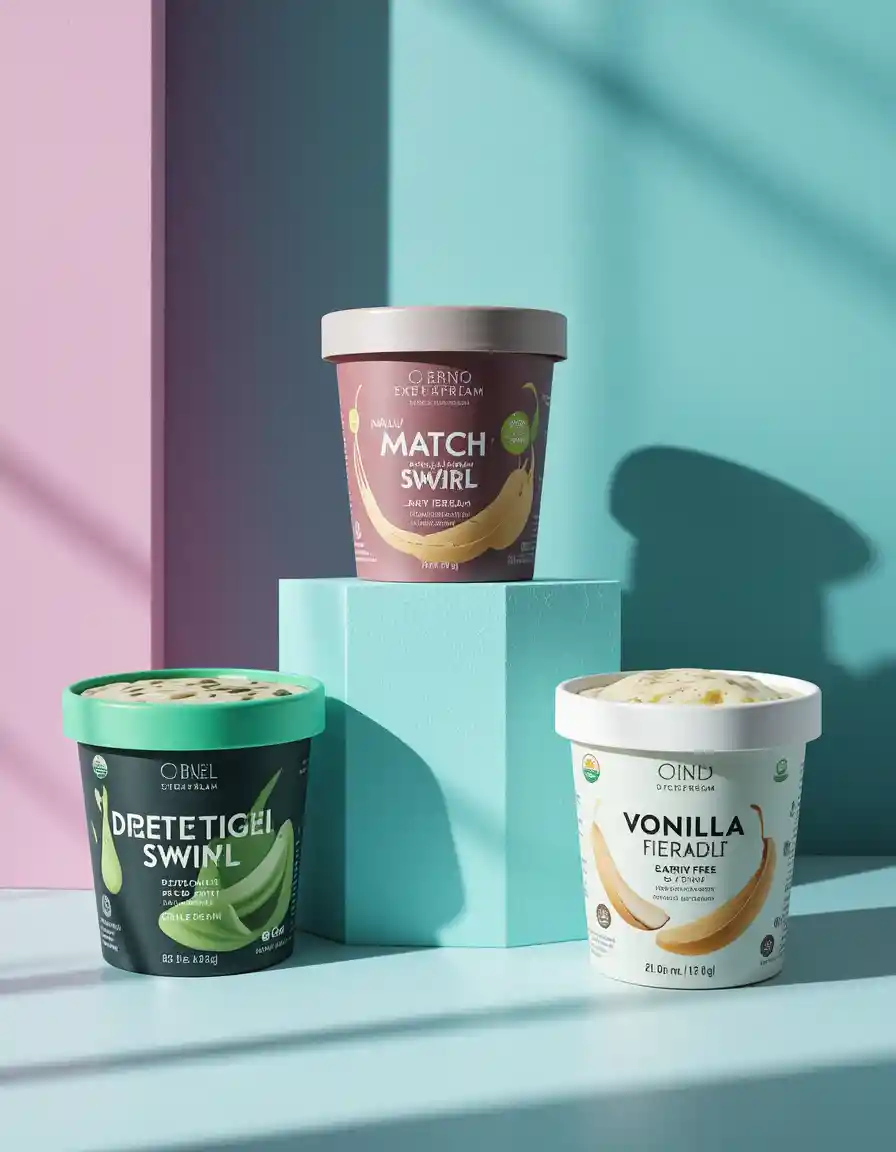Ice Cream Bankruptcies
Ice cream bankruptcies are on the rise—and no, you’re not imagining it.
Did your favorite scoop spot just shut down? Or maybe you noticed fewer pints on the freezer shelves? Well, it’s not just a summer slump—it’s a full-on meltdown happening across the dessert world.
The truth is, ice cream brands and shops are going out of business faster than you can say “double chocolate fudge.” Skyrocketing ingredient costs, stiff competition, and changing customer habits are all putting the freeze on what used to be a sweet and stable business. And if you’re in the food game—or just love a good cone—this should be on your radar.

But here’s the scoop: in this post, you’ll find out why this is happening, which brands are melting under the pressure, and what’s next for the frozen dessert industry. Whether you’re a foodie, an entrepreneur, or just curious about the chaos behind the counter, this exclusive breakdown will give you the full story—no fluff, just facts (and a few sprinkles).
Ready to dig in? Let’s break it down before it melts away.
Table of Contents
The Big Freeze: What’s Causing Ice Cream Bankruptcies in 2025?
Let’s be real—ice cream bankruptcies aren’t just about bad business decisions. Behind every closed scoop shop or empty pint brand, there’s usually a storm of bigger issues swirling around. And yeah, it’s a lot deeper than just “people not craving dessert anymore.”
So… what’s really behind this meltdown?

1. Soaring Ingredient Costs
Milk, cream, sugar, vanilla—prices for these essentials have jumped through the roof. Add in the premium stuff like chocolate, pistachios, or fruit purées, and suddenly a basic batch costs double what it did just a few years ago. For small brands, especially, staying profitable became a losing game.
“We had to either raise our prices or start cutting corners,” one Midwest shop owner said. “Neither choice felt good.”
2. Inflation & the Pinched Wallet Effect
Let’s face it—when rent, gas, and groceries are breaking the bank, that $7 artisan ice cream cup doesn’t seem like a smart buy anymore. People are choosing cheaper store-brand pints or skipping dessert altogether. This shift in spending is hitting independent and craft ice cream businesses the hardest.
3. Overcrowded Market
It feels like every week there’s a new dairy-free, protein-packed, keto-friendly brand entering the freezer aisle. Cool for the consumer—but brutal for existing players. Even some legacy brands are losing shelf space to newer, flashier names. The result? Too many cones, not enough customers.
4. Supply Chain Woes
From packaging shortages to delayed shipments of imported flavorings, the post-pandemic supply chain mess has wreaked havoc on the frozen dessert industry. When you rely on fresh dairy and seasonal fruits, even a week’s delay can throw production off course.
5. Changing Tastes & Health Trends
Americans are getting pickier about what they eat—less sugar, more protein, plant-based everything. Traditional brands that didn’t adapt fast enough got left in the cold. Meanwhile, upstarts that did pivot often found it hard to scale without blowing the budget.
🔍 Bottom Line?
Ice cream bankruptcies aren’t caused by just one factor—they’re the result of rising costs, evolving consumer preferences, and widespread changes within the industry. Without swift innovation, more brands could follow suit.

Big Names That Melted: Notable Ice Cream Brand Bankruptcies
Ice cream has always felt like one of those “safe” pleasures—no matter what, people want their favorite frozen fix, right? Well, the last few years have proved otherwise. From cult-favorite startups to well-known legacy brands, ice cream bankruptcies have taken a serious toll on the dessert aisle.
Here are some of the biggest names that couldn’t survive the meltdown:
1. Coolhaus – Crumbled Under Pressure
Once a trendy, woman-founded brand known for gourmet ice cream sandwiches and unique flavors like “Street Cart Churro Dough,” Coolhaus made headlines for its innovative spirit. But in 2023, it quietly disappeared from many shelves. High production costs and distribution challenges forced it to scale back drastically—a move that signaled bigger trouble behind the scenes.
💬 “We just couldn’t compete on price anymore without sacrificing our values,” one former team member shared anonymously.
2. Ample Hills – From Boom to Bust
This Brooklyn-born scoop shop once had Disney partnerships and massive lines down the block. But despite all the buzz, Ample Hills filed for bankruptcy in 2020 and later had to shut down many of its locations. Their downfall was blamed on rapid over-expansion, mismanaged finances, and underestimating how tough the ice cream biz really is—even in a city that loves dessert.
3. Local Legends & Regional Losses
Beyond the big brands, dozens of local favorites across the U.S. have vanished quietly. Beloved neighborhood scoop shops, family-run creameries, and small-batch producers have all been hit hard by rising costs and tighter consumer budgets. While not always covered in national news, these are the real heart of America’s frozen dessert culture, and their losses hit home.
4. Startups That Never Got a Second Scoop
In the past five years, dozens of VC-backed frozen dessert startups promised the next “Halo Top moment,” offering everything from adaptogen-infused pints to mushroom-based cones. But when investor dollars dried up and sales didn’t meet hype, many of these brands fizzled out before they hit mainstream stores.
Why It Matters
These ice cream bankruptcies aren’t just cautionary tales—they reflect a shifting landscape where creativity, quality, and even loyal fans aren’t always enough. Brands now face a tougher reality: survive the squeeze or melt under the heat.

Behind the Counter: Voices from the Ice Cream Bankruptcies Crisis
While big headlines focus on corporate collapses and brand bankruptcies, the real story often lives behind the counter, with the local shop owners, employees, and families who’ve poured their hearts (and savings) into scoops and sundaes. Ice cream bankruptcies hit hardest on the ground, where passion meets pressure every day.
Here’s what folks inside the biz are saying:
💬 “It broke my heart to close the doors.”
Maya, a small-town scoop shop owner in Ohio, ran her family ice cream parlor for over 12 years. “It was my dream,” she said. “We survived COVID, but the price of dairy and rent just kept rising. People were coming in less. We were working harder and earning less. Eventually, we had to let it go.”
Ice cream may be sweet, but running a shop in 2025 is anything but.
💬 “Customers love the product—just not the price tag.”
James, who managed a franchise location in Arizona, said inflation changed everything. “We used to sell a double scoop for $3. Now it’s close to $7, and folks just aren’t biting anymore.” He mentioned how foot traffic dropped by 40% in one summer, and no amount of TikTok marketing could fix that.
💬 “We had to switch from passion to survival mode.”
Lisa and her husband launched a plant-based ice cream truck in California back in 2019. It was a hit at first—lineups every weekend. But when ingredient costs soared and food truck permits became more expensive, profits melted fast. “We weren’t chasing dreams anymore—we were just trying to not go bankrupt.”
Industry Insiders Weigh In
Even distributors and suppliers are feeling the chill. A packaging vendor from New Jersey explained, “We lost five ice cream clients in one year. It’s like a domino effect. When one brand folds, several others around it take a hit too.”
The Human Scoop
Behind every shuttered shop is a story of ambition, resilience, and tough decisions. These voices remind us that ice cream bankruptcies aren’t just economic stats—they’re personal losses. And for many, the toughest part isn’t the financial fallout… It’s walking away from something they loved.
✅ Next up?
Let’s explore how this frozen crisis affects you as a customer, and what it says about the bigger picture: the economy, the cost of living, and why even your dessert choices are feeling the heat.

A Tough Sundae to Swallow: How the Economy Affects Your Cone
When you think about ice cream bankruptcies, it’s easy to picture big companies or trendy shops shutting down—but what does that mean for you at the checkout line?
The truth is, the economy’s been giving the ice cream biz a serious brain freeze, and it’s trickling down to your cone, pint, or sundae.
- Rising Costs = Pricier Treats
Everything that goes into your favorite frozen dessert is costing more—milk, cream, sugar, and even packaging. When producers face these rising expenses, they have to pass some of that cost to you. That $3 scoop? It’s now closer to $6 or $7 in many places. And yeah, that stings. - Pinching Pennies, Changing Habits
With inflation squeezing wallets tighter than ever, folks are making tough choices. That means fewer ice cream runs, smaller portions, or switching to cheaper grocery store brands. It’s no surprise that ice cream bankruptcies spike when customers cut back on “non-essentials,” and dessert often falls into that category. - Supply Chain Snags Make Things Worse
Remember all those delays and shortages during the pandemic? The ice cream world felt it was hard. Delays in shipping and packaging shortages meant some flavors disappeared, production slowed down, and shelves sometimes looked pretty sad. All this chaos makes it harder for brands to keep costs down and stay in business. - The Ripple Effect on Local Shops
When national brands struggle, local scoop shops feel the pinch too. Increased wholesale prices, higher rent, and fewer customers add up fast. Some smaller spots have had to raise prices so much that loyal customers start thinking twice before ordering their usual cone.
Bottom line: The economy isn’t just making your ice cream more expensive—it’s reshaping the entire dessert scene. And until things cool down, ice cream bankruptcies will keep happening, changing the way we indulge in our favorite sweet treat.

What’s Next? Future of the Ice Cream Industry
With so many ice cream bankruptcies shaking up the market, you might be wondering—what’s next for this beloved frozen treat? Is the ice cream biz doomed, or is there hope on the horizon?
The answer is a bit of both.
Innovation Is Melting Barriers
Brands that survive (and thrive) are those that get creative. We’re talking about next-level flavors like vegan gelato, protein-packed pints, and even ice creams infused with adaptogens or CBD. These fresh takes aren’t just gimmicks—they’re meeting changing consumer demands head-on.
Small Is the New Sweet
While giant brands struggle to keep up, many local and artisanal shops are finding ways to shine. By focusing on quality ingredients, unique recipes, and personal connections with customers, these smaller players are carving out loyal fan bases. It’s less about mass production and more about community vibes.
Tech and Delivery Shake-Ups
The rise of food delivery apps and online ordering is a game-changer. Ice cream brands are exploring direct-to-consumer models, subscription boxes, and contactless delivery to keep scoops coming even when customers stay home. Plus, AI and data are helping companies predict trends and reduce waste.
Sustainability on the Menu
Consumers care more than ever about where their food comes from. Eco-friendly packaging, ethically sourced ingredients, and lower carbon footprints are becoming must-haves. Brands ignoring this risk are losing their audience—and their freezer space.
What Does This Mean for You?
The ice cream industry might be going through some rough patches, but it’s far from dead. Expect more innovation, more options tailored to your lifestyle, and more ways to enjoy your favorite treat, just maybe with a new twist.

Tips for Ice Cream Entrepreneurs: Stay Cool in a Melting Market
If you’re running an ice cream business or thinking about jumping into the frozen dessert game, the rising wave of ice cream bankruptcies is a warning—and a wake-up call. But don’t pack up your scoops just yet! Here are some solid tips to keep your business from melting away:
1. Get Smart with Pricing
Raising prices can be tough, but it’s necessary if costs are climbing. Be transparent with your customers—let them know why prices went up. Offering smaller portion sizes or combo deals can help customers feel they’re still getting value.
2. Innovate Your Flavors and Options
Consumers want novelty—vegan, keto, low-sugar, or protein-packed. Experiment with new recipes that tap into health trends without sacrificing taste. Staying ahead of the curve can set you apart from competitors.
3. Build a Strong Online Presence
Social media isn’t just for sharing mouthwatering photos (though that helps!). Engage with your community, run contests, share behind-the-scenes content, and make it easy for customers to order online or schedule pickups.
4. Focus on Local and Sustainable
Support local suppliers and highlight your commitment to eco-friendly practices. Customers love brands that care about the environment and community. It’s good for business and the planet.
5. Diversify Your Revenue Streams
Don’t rely solely on in-store sales. Think catering, special events, subscription boxes, or collaborations with other local businesses. The more ways you connect with customers, the better your chances of weathering the storm.
Bottom line: The rise of ice cream bankruptcies shows the market is tough, but smart, adaptable businesses can still scoop out success. Stay flexible, listen to your customers, and keep your passion alive.

Final Scoop: Is Ice Cream Still a Good Business in 2025?
After all we’ve covered—rising costs, fierce competition, and those tough stories behind the counter—you might be asking: Is ice cream still a good business in 2025?
The short answer? Yes, but it’s no walk in the park.
The wave of ice cream bankruptcies shows us that the old playbook isn’t enough anymore. To make it, you need a fresh approach—whether that means embracing innovation, focusing on your community, or smartly managing your costs.
Why Ice Cream Can Still Be a Sweet Business
- People will always crave a cold, creamy treat. It’s a universal joy that rarely fades.
- New trends, like plant-based and health-conscious options, open doors to new audiences.
- Technology makes reaching customers easier than ever through delivery apps and social media.
But Don’t Sugarcoat It
Success means adapting to a market that’s tougher than ever before. That means knowing your numbers, staying nimble, and listening closely to what your customers want. The brands that do this won’t just survive—they’ll thrive.
So, what’s the final scoop? Ice cream remains a promising business—but only if you’re ready to innovate, hustle, and keep your cool when the heat is on.
My Latest Recipes
Conclusion
The story of ice cream bankruptcies is a powerful reminder that even the sweetest businesses face serious challenges. But with every setback comes opportunity—whether it’s through innovation, community connection, or adapting to new trends, the ice cream industry still has plenty of room to grow and delight.
Thank you for sticking with us through this deep dive into the frozen dessert world’s ups and downs. We hope this article gave you fresh insights and a better understanding of what’s happening behind the scenes.
If you enjoyed this post, don’t stop here! Check out our other articles packed with tips, trends, and tasty ideas to keep you ahead in the food business or simply satisfy your craving for knowledge.
Stay cool, keep scooping, and see you in the next read!
Related Recipes You Will Love
Frequently Asked Questions About Ice Cream Bankruptcies
1. Why are so many ice cream companies filing for bankruptcy?
Answer: Rising ingredient costs, inflation, supply chain disruptions, and changing consumer preferences are the main drivers behind the recent surge in ice cream bankruptcies. Many brands struggle to keep prices competitive while maintaining quality.
3. Are small ice cream shops more vulnerable to bankruptcy?
Yes, smaller local shops often have thinner profit margins and less access to capital. They feel the impact of rising costs and reduced foot traffic more acutely, making them more susceptible to the wave of ice cream bankruptcies.
4. What trends are helping ice cream businesses survive in 2025?
Innovation, such as plant-based options, healthier alternatives, unique flavors, and embracing delivery apps are key trend helping some brands avoid ice cream bankruptcies and stay competitive.
5. Can ice cream be a profitable business in 2025?
Absolutely, but it requires adapting to market changes, smart pricing strategies, engaging marketing, and a focus on sustainability and customer experience to avoid joining the growing list of ice cream bankruptcies.
Share your thoughts or questions about the recipe in the comments below!






